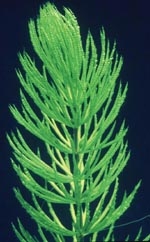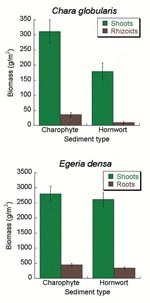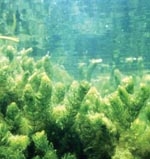PDF of this article (317 KB)

Fleur Matheson Mary de Winton John Clayton Tracey Edwards
Experimental work points to yet another way that a major aquatic weed damages New Zealand lakes.
Hornwort (Ceratophyllum demersum) is an invasive, submerged weed that has a major effect on habitat quality in New Zealand’s freshwater environments. Like other water weeds (such as egeria and lagarosiphon), hornwort can form dense, unsightly, and hazardous weed beds which can displace our valuable native plant communities and remove vital habitat for fish and other freshwater biota. Now research by NIWA scientists also indicates that the litter and debris laid down beneath hornwort weed beds might pose a potent barrier to efforts to restore native habitat.
Some native plants don’t like hornwort sediment



We planted the native charophyte Chara globularis and the invasive weed egeria (Egeria densa) in containers of sediment collected from beneath native charophyte beds and hornwort weed beds found in two North Island lakes (Tarawera and Rotorua). As the graphs show, C. globularis growth in the hornwort sediments was greatly reduced compared to its growth in the charophyte sediments. Interestingly, the growth of the invasive weed egeria was not significantly impaired.
In a related experiment we tested the germination and survival response of C. globularis oospores (seeds) on these two sediment types over five months. Although the overall germination response was slightly lower on hornwort sediment, the difference was not significant. However, this may be due to germling insensitivity to the environment while reliant on oospore reserves in the early stages of development. Our results with the mature transplanted specimens strongly suggest that growth would eventually be hindered at a later stage in their development.
Although other invasive weeds are known to grow as vigourously as hornwort and to also contribute high levels of litter to underlying lake sediments, we suspect that the impact of hornwort on lake sediments may be greater than for other weeds due to this species’ unusual physiology (see “Hornwort’s unique growth habit” below).
Restoration of native lake habitat
Native aquatic plants are a preferred vegetation type in most freshwater environments as they provide essential habitat for important freshwater biota including koura (crayfish), bullies and other native fish, and invertebrates. In addition, the low growth (usually less than 2 m in height) of “charophyte meadows” seldom causes weed problems and they stabilise lake bed sediments and promote clear water conditions.
Restoration of native vegetation is highly desirable, particularly where beds of invasive weeds can be removed or have collapsed, as often occurs in shallow lakes. Native aquatic vegetation can be restored from lake sediment seed banks (provided they haven’t been buried too deeply under weed detritus) or by transplanting whole plants. These strategies have been used in Lake Rotoroa in Hamilton and Lake Rotomanuka near Te Awamutu, although in these lakes we have had to protect developing plants with cages due to the presence of herbivorous coarse fish (rudd). However, the results of our study suggest that survival of transplanted charophytes (and possibly seedbank germlings at later stages of development) may be poor, at least initially, on hornwort-affected lake sediments.
Future research
Ongoing research at NIWA continues to address the effects of hornwort weed on native aquatic plant communities and lake sediment and water quality, with experiments planned at a number of key sites in Lake Taupo.
Hornwort’s unique growth habit

Hornwort is unusual amongst submerged weeds as it doesn’t develop true roots but anchors itself to bottom sediments by buried stems. It is thought to absorb nutrients for growth entirely from the water instead of the sediments; in contrast, other submerged weeds have roots and rely mainly on sediment sources. While hornwort’s growth habit may be disadvantageous in situations where nutrient levels are low in the water and higher in sediments, it may be an advantage in situations where unfavourable sediment conditions develop, such as where high levels of organic detritus accumulate as a result of vigorous weed or algal growth.
Hornwort weed can form very dense, tall weed beds (up to 7 m high) in the littoral zone of lakes. Its loose attachment to sediments means that it is easily dislodged by wind or wave action. As a consequence, large rafts of floating weed can develop and these are often seen in the Waikato hydrolakes where this weed frequently blocks dam intakes.
Vascular versus non-vascular plants

The results of our experiments support the idea that vascular plants (such as egeria) are more tolerant of unfavourable sediment conditions than non-vascular plants (such as Chara globularis). Vascular plants differ from non-vascular plants in that they have an intercellular lacunal tissue that can store and transport oxygen to roots to support respiration and nutrient uptake. Some of this oxygen is also released to the surrounding sediment, which helps to detoxify reduced compounds like hydrogen sulphide and volatile fatty acids that form in sediments under anoxic conditions. Non-vascular plants, like charophytes, do not have lacunal tissue and may therefore be much more susceptible to unfavourable sediment conditions.
The diagram shows generalised differences between non-vascular and vascular submerged plants. Vascular plants have a much more complex arrangement of internal tissues for transport of oxygen (lacunae), water, and nutrients (xylem and phloem). (Click for enlargement)
Fleur Matheson, Mary de Winton, John Clayton, and Tracey Edwards are based at NIWA in Hamilton.
Teachers’ resource for NCEA AS: Science 2.2; Biology 2.7, 2.9, 3.2. See other curriculum connections at www.niwa.co.nz/pubs/wa/resources
This research was carried out as part of NIWA’s FRST-funded “Aquatic Plant Management” programme (C01X0221).
